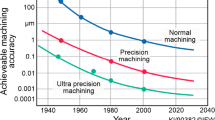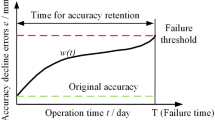Abstract
This article is devoted to improvement of a nondestructive control of metal machine parts by the contact potential difference method. The results of experimental studies of the effect of environmental parameters on the contact potential difference measurements with a Kelvin probe on the surface of metal samples from Al, Ti, and Ni are presented. The measured dependence of the contact potential difference on the surface of metals on the environmental parameters has been explained. Practical recommendations for measuring the contact potential difference on the surface of parts have been given. The results can be used in production, operation, and repair of metal machine parts.
Similar content being viewed by others
REFERENCES
Betsofen, S.Ya., Gordeeva, M.I., Knyazeva, Yu.A., Sbitneva, S.V., Panteleev, M.D., and Bakradze, M.M., Phase composition formation in a V-1469 alloy (Al–Cu–Li system) during friction stir welding, Russ. Metall., 2018, vol. 2018, no. 11, pp. 1059–1066.
Gerasimov, I.V., Kravchenko, G.N., and Kravchenko, K.G., Recovery of fatigue life of 30HGSN2A steel aircraft parts by repeated shot peening, J. Phys.: Conf. Ser., 2019, vol. 1399, no. 4, p. 044030. https://doi.org/10.1088/1742-6596/1399/4/044030
Ryapukhin, A.V., Kabakov, V.V., and Zaripov, R.N., Risk management of multimodular multi-agent system for creating science-intensive high-tech products, Espacios, 2019, vol. 40, no. 34, p. 19.
Bespalov, A.V., Petrov, A.P., and Sokolov, A.V., Friction and surface phenomena during stamping of hard-to-form alloys, Vestn. Mosk. Aviats. Inst., 2017, vol. 24, no. 3, p. 179.
Shishkin, S.V., Boikov, A.A., and Kolpakov, A.M., To the calculation of the strength of a Z-shaped elastically-plastically deformable metal seal with incising elements, Tr. MAI, 2019, no. 109. https://doi.org/10.34759/trd-2019-109-9
Kalmykov, V.V., Musokhranov, M.V., and Smirnov, O.O., Assessment of the effect of parameters of electrical signals when measuring the contact potential difference, Din. Slozhnykh Sistem – XXI Vek, 2018, vol. 12, no. 2, p. 56.
Samoilenko, V.M. and Oleshko, V.S., Application of the device for measuring the contact potential difference “Poverkhnost-11” in nondestructive testing of machine parts, Oboronnyi Kompleks – Nauchno-Tekh. Prog. Ross., 2011, no. 2, p. 3.
Shebzukhova, I.G. and Aref’eva, L.P., Anisotropy in the electronic work function of crystals of 3d metals, Bull. Russ. Acad. Sci., Phys., 2015, vol. 79, pp. 811–814. https://doi.org/10.3103/S1062873815060301
Örnek, C., Leygraf, C., and Pan, J., Real-time corrosion monitoring of aluminum alloy using scanning Kelvin probe force microscopy, J. Electrochem. Soc., 2020, vol. 167, no. 8. https://doi.org/10.1149/1945-7111/ab8826
Babich, A.V., Pogosov, V.V., and Reva, V.I., Calculation of the probability of trapping a positron by a metal vacancy and an estimate of the vacancy contribution to the work function of electrons and positrons, Fiz. Met. Metalloved., 2016, vol. 117, no. 3, p. 215.
Surovoi, E.P., Titov, I.V., and Bugerko, L.N., Contact potential difference for azides of lead, silver, and thallium, Izv. Tomsk. Politekh. Univ., 2005, vol. 308, no. 2, p. 79.
Oleshko, V.S., RU Patent 2488093, 2013.
Yurov, V.M. and Oleshko, V.S., The impact of the environment on the contact potential difference of metal machine parts, Eurasian Phys. Tech. J., 2019, vol. 16, no. 1, p. 99.
Huber, S., Wicinski, M., and Hassel, A.W., Suitability of various materials for probes in scanning Kelvin probe measurements, Phys. Status Solidi A: Appl. Mater. Sci., 2018, vol. 215. https://doi.org/10.1002/pssa.201700952
Author information
Authors and Affiliations
Corresponding author
Additional information
Translated by G. Dedkov
About this article
Cite this article
Oleshko, V.S. The Effect of Environmental Parameters on Nondestructive Control of Metal Machine Parts by the Contact Potential Difference Method. J. Mach. Manuf. Reliab. 49, 550–554 (2020). https://doi.org/10.3103/S1052618820060060
Received:
Accepted:
Published:
Issue Date:
DOI: https://doi.org/10.3103/S1052618820060060




